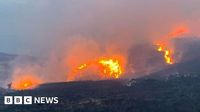Ministers, land managers, and emergency services gathered in the Cairngorms National Park on October 14, 2025, for a landmark summit aimed at tackling Scotland’s escalating wildfire crisis. This special meeting, hosted by the Scottish Government in Grantown, comes on the heels of the largest wildfires in living memory—a year that saw 13 wildfire alerts and more than 200 incidents, including devastating blazes at Carrbridge and Dava that scorched over 11,000 hectares (27,000 acres) of land.
The summit brought together leading figures from the Scottish Fire and Rescue Service (SFRS), NatureScotland, Scottish Land and Estates, and a range of environmental organizations and land managers. Agriculture Minister Jim Fairlie and Community Safety Minister Siobhian Brown jointly chaired the event, underscoring the government’s commitment to learning from recent events and shoring up Scotland’s resilience against future wildfires.
Fairlie did not mince words about the scale of the challenge. "It took an astonishing effort across so many sites to tackle the wildfires we saw this year, and we are grateful to all those who helped," he told attendees, according to BBC News. He emphasized that the summit offered "a chance for us to look at what worked, and what lessons we need to learn from what happened."
Brown echoed the sentiment, highlighting the Scottish Government’s close engagement with the SFRS, local communities, and other key groups in the aftermath of this summer’s blazes. She stated, "We continue to support the full implementation of the SFRS wildfire strategy, which will see the continued roll-out of new equipment, vehicles and personal protective equipment." Her remarks, reported by STV News, reflect a broader governmental push to modernize Scotland’s wildfire response capabilities in 2025.
The urgency of these efforts is hard to overstate. The wildfires at Carrbridge and Dava, which raged in late June and early July, were described by local landowners as the largest in living memory. The impact was immense: experts believe thousands of animals—including curlew, grouse chicks, and hares—perished in the flames. Smoke from the Carrbridge blaze drifted as far as 40 miles across the Moray Firth, a stark reminder of the fires’ reach and destructive power.
According to the SFRS, wildfires are classified as large and uncontrolled outdoor fires that burn more than 1,000 square meters. They are, by nature, unpredictable and unplanned, often igniting in areas with combustible vegetation that allows flames to spread rapidly. Human activity remains a frequent culprit—barbecues, discarded cigarettes, and even glass bottles magnifying sunlight on dry grass can all trigger disaster. In the Highlands, peaty soil can fuel these fires for days, sometimes burning deep into earth that has accumulated over thousands of years.
SFRS assistant chief officer Jon Henderson painted a sobering picture of the challenge facing emergency services. "This year Scotland has faced an unprecedented scale of wildfire risk, and our crews have attended more than 200 wildfires across the country," he said, as reported by both BBC News and STV News. "Wildfires can employ a significant amount of our resources, they also have the potential to burn for days and devastate vast areas of land and wildlife, threatening the welfare of nearby communities." Henderson stressed the importance of collaboration, adding, "We will continue to work closely with our partners, landowners and communities in both our response and, importantly, to help prevent wildfires." He welcomed the opportunity for the SFRS to participate in the summit.
The environmental toll of the wildfires has been severe and is expected to linger. Colin McClean, head of land management at the Cairngorms National Park Authority, warned that the fires would have a long-lasting impact on the natural environment. "The park is introducing clear, practical measures to reduce wildfire risk," he said, according to BBC News. McClean also welcomed the summit, noting that it "provides an opportunity for critical conversations to take place on wildfire mitigation and management." He added, "Coming together at events like this will help strengthen that work and ensure we are as prepared and resilient as possible."
In response to the crisis, the Cairngorms National Park Authority has begun implementing a suite of practical measures designed to reduce wildfire risk and improve preparedness. While the specifics of these measures were not detailed at the summit, the emphasis on collaboration and knowledge-sharing was clear. As McClean put it, "Events like this will help strengthen that work and ensure we are as prepared and resilient as possible."
The Scottish Government’s support for the SFRS wildfire strategy has been a focal point of the response. This includes the ongoing roll-out of new equipment, vehicles, and personal protective equipment for firefighters—a critical investment as the scale and frequency of wildfires increase. Ministers also announced plans for a roundtable event with Members of the Scottish Parliament (MSPs) after Holyrood returns from the October recess, aiming to sustain momentum and keep wildfire preparedness high on the legislative agenda.
Wildfires, by their very nature, are a complex foe. They do not respect property boundaries, and their causes are often rooted in both human behavior and environmental conditions. This year’s blazes were fueled by dry conditions and exacerbated by human negligence, but the summit made clear that tackling the problem will require a multi-faceted approach. Education, prevention, investment in equipment, and cross-sector collaboration all play a role.
Despite the devastation, there is a sense of determination among those involved. The summit’s participants—from ministers to firefighters, land managers to environmentalists—expressed a shared commitment to turning the lessons of 2025 into actionable change. As Scotland faces an uncertain climate future, the hope is that these conversations and new strategies will help safeguard its landscapes, wildlife, and communities from the growing threat of wildfires.
For now, the scars of this year’s fires are still visible across the Highlands. But with renewed focus, practical measures, and a willingness to learn, Scotland is taking steps to ensure it is better prepared for whatever challenges lie ahead.




